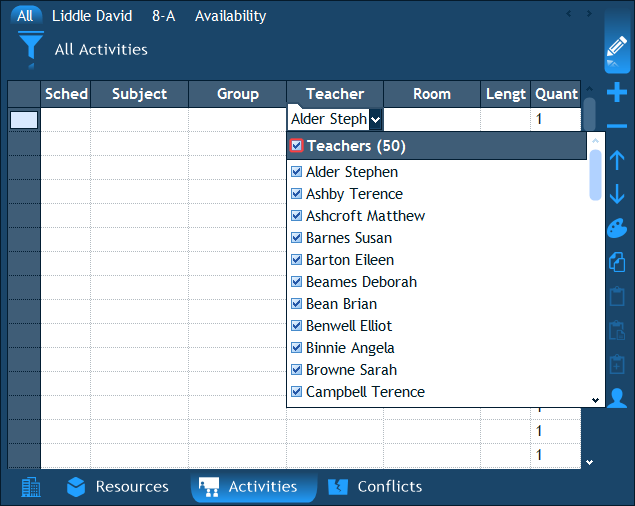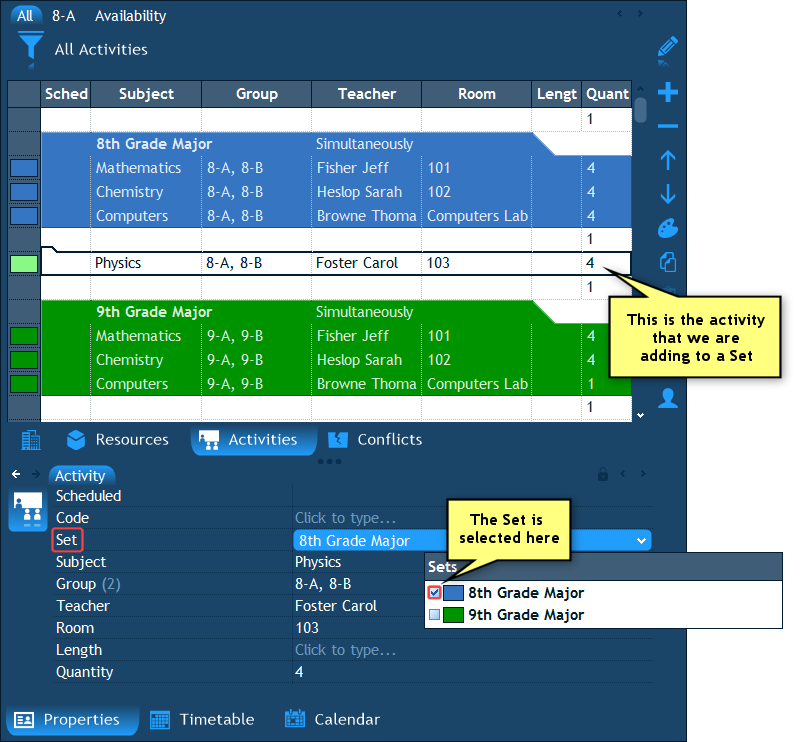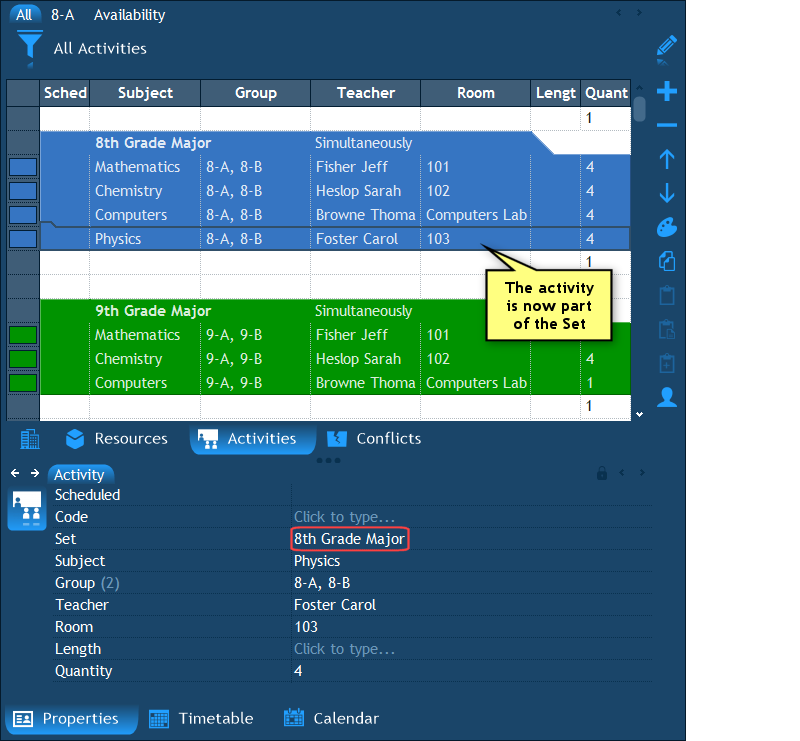 Activities
Activities
|
User's Guide Topics
|
The Activities pane follows the Resources pane and is the third pane of data entry.
![]()
The entry of activities is the most important phase of data entry because as you will soon learn, activities are the fundamental building blocks of the timetable.
Contents
- 1 What are activities?
- 2 Activities' List
- 2.1 Scenario 1: Subject, Group and Teacher
- 2.2 Scenario 2: Subject, Group, Teacher and a Single Room
- 2.3 Scenario 3: Subject, Group, Teacher, and Multiple Possible Rooms
- 2.4 Scenario 4: Multiple Groups, Multiple Teachers, Simultaneous Activities
- 2.5 Scenario 5: Direct Enrollment of Students to Activities
- 2.6 How to select which columns are visible?
- 3 Entry of Activities
- 3.1 How to add activities?
- 3.2 How to edit activities?
- 3.3 How to fill in the values of an activity?
- 3.4 How to quickly select a single resource in a popup list?
- 3.5 How to modify a property of multiple activities at once?
- 3.6 How to quickly create an activity for each resource?
- 3.7 How to select multiple items of the same equipment?
- 3.8 How to enter length and quantity?
- 4 Sets
- 5 Assisted Assignment of Resources
What are activities?
An activity is an association of several resources which are to be scheduled together.

A few facts about activities:
- When an activity is scheduled at a particular time, all its participating resources are booked for that activity at that time.
- If you delete an activity from the timetable of one of its resources, it will be deleted from all of them.
- A single activity can be scheduled many times during the week. Each occurrence of the activity is considered as one cell in the timetable. The total planned number of cells during the week is entered in the activity's Quantity property.
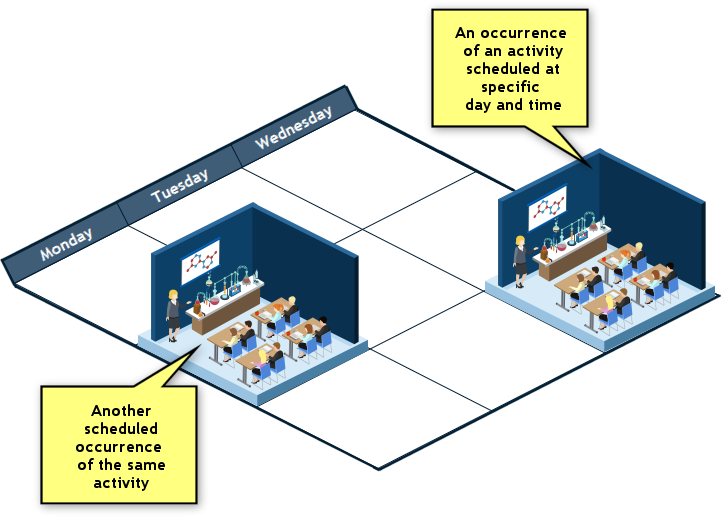
- When an activity needs to span over several consecutive periods, its Length property specifies that number of periods. For example, an activity which should always be scheduled on two consecutive periods will have a Length of "2".
- An activity does not necessarily need to include all the types of resources. For example, an activity can be created without specifying a room, students or equipment.
- An activity can include several resources of the same type. For example, it can have 3 teachers and occupy 2 rooms.
- Different cells of the same activity can involve different resources. For example, on Monday the activity can be scheduled in Room 1 and on Wednesday in Room 2. This is explained in detail below.
- Multiple activities which need to be scheduled simultaneously can be bundled into a Set, as explained below.
Activities' List
The list of activities is located in the Activities pane. It is basically a spreadsheet of rows and columns where each row represents one activity and the columns contain the resources which are involved in the activity, as well as other data about the activity (statistical figures and/or custom textual properties). The exact columns which are important to be displayed in this list is something that is institution-specific - it varies between one institution and another. So let's go over a few common scenarios and see some examples of how the activities' list can look like.
Scenario 1: Subject, Group and Teacher
This is the most basic type of activities: each activity involves just one named group of students (without explicitly listing the students), one teacher and a subject. This scenario is most common in elementary schools in which each group has a single classroom, and all the activities of that group take place in that single classroom. Thus room entry becomes redundant because the name of a group implies the classroom and as a result rooms are not even a part of the list of activities:
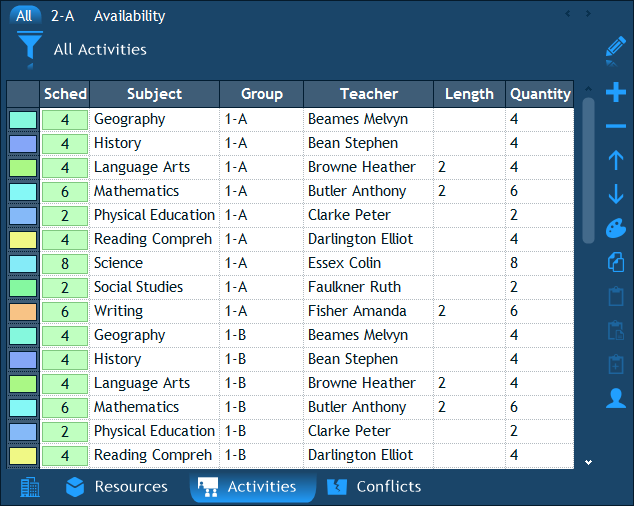
A few notes which are relevant to this scenario but also to all the scenarios below:
- The leftmost column in the list contains a color which was assigned to one of the activity's resources. In most examples, colors have been assigned to subjects so the color that appears in this column is usually the activity subject's color.
- The "Sched." column that you see at the left hand side depicts the amount of periods each activity has been scheduled for (the screenshots have been taken after the activities have already been scheduled).
- The Length is the duration of one occurrence of an activity.
- The Quantity is the total planned duration of all the activity's occurrences during the week.
- The length of an activity can be, for instance, "2" and the quantity "4". This means that the activity should always occupy two consecutive periods and should be scheduled on a total of 4 periods during the week (i.e. 2 occurrences of 2 periods each). When the length is a single period, there is no need to enter "1" in the Length field because 1 is the default.
Scenario 2: Subject, Group, Teacher and a Single Room
This scenario is very similar to the previous one, only in this case each activity is also assigned a room. We are starting from the simple case here in which each activity is allowed to be scheduled only in one particular room. That room is selected in the Room column of the activities' list:
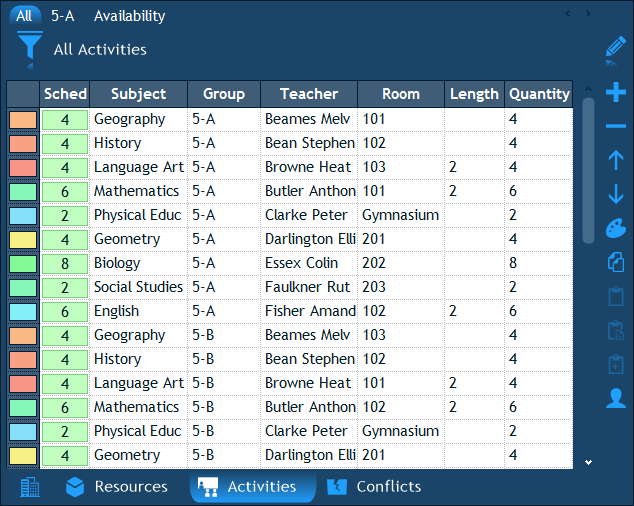
Scenario 3: Subject, Group, Teacher, and Multiple Possible Rooms
In this scenario activities have a subject and a single teacher but can be scheduled in a multitude of suitable rooms. Each occurrence of the activity can be scheduled in a different room:
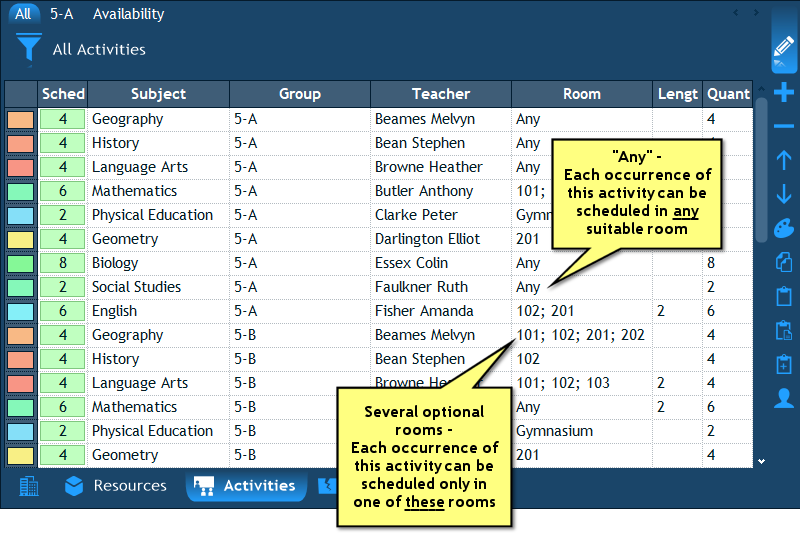
There are two ways to specify that a room can be selected on a per-cell basis (a cell is a single occurrence of the activity), rather than be the same for all the cells of the activity:
- The first way is to select the option "Any" at the bottom of the popup list of rooms (and not select anything else). In such case, the program will allow every cell of the activity to have a different room, selected for it separately:
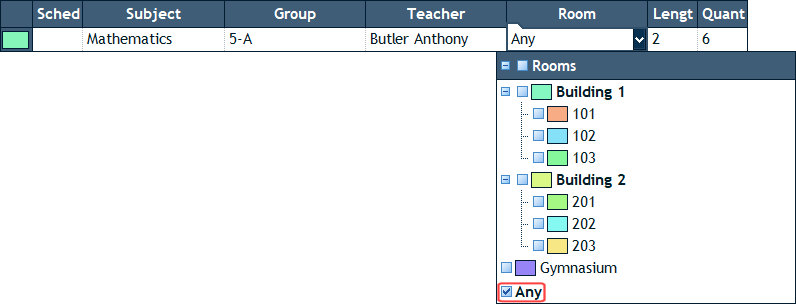
- The second way is to select multiple possible rooms in the popup list, but also place a check mark near the option "Any of the selected" at the bottom. Once you do that, you will be able to select rooms per cell (and in the Automatic mode this will be done automatically by the software), but only out of the optional rooms you have chosen:
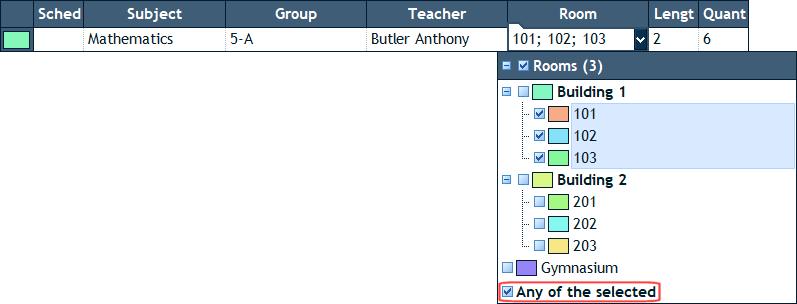
Scenario 4: Multiple Groups, Multiple Teachers, Simultaneous Activities
In many schools it is quite common for several groups, teachers or even entire activities to be required to be scheduled at the same time - simultaneously. Here are some examples:
- A Gym activity may require two teachers: one for the boys and one for the girls.
- Two groups of students are united together to participate in one Arts & Crafts activity.
- Students of the 8th grade are split to 3 simultaneous Math activities according to the students' level in Math. Each activity has its own teacher and room.
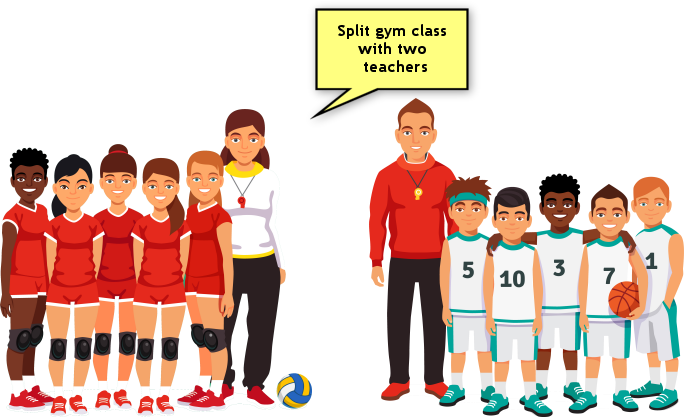
Here's how the above examples would appear in the activities' list:
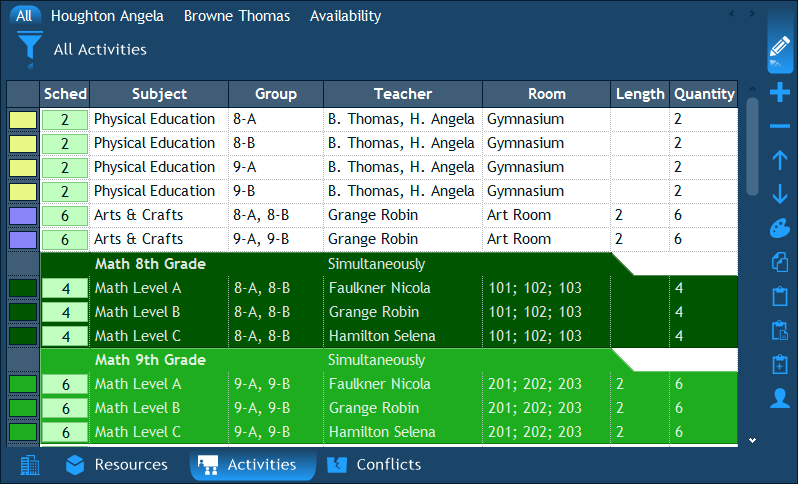
To select multiple resources in any field, you just need to click inside the check boxes near the relevant resource names in the popup list (when you are editing the field):

The grouped Math activities in the example above with the word "Simultaneously" above them are called Sets. The creation of such Sets is described below.
Scenario 5: Direct Enrollment of Students to Activities
As opposed to the previous scenarios, where groups such as "8-A" and "9-A" were used to refer to certain recurring assemblies of students, in this scenario each activity defines its own list of students explicitly. In fact, groups as a type of resource, are not used in this scenario at all (any type of resource can disabled altogether in the Vocabulary page). Instead, here, each activity has a subject, teacher and room, and also a column named "Students" where the students who participate in the activity are explicitly selected.
You will notice that in this scenario there is also an additional helpful custom property named '"Section"' that is defined for each activity. This is merely a textual field which is used to differentiate between two similar activities of the same subject and teacher but which involve different students.
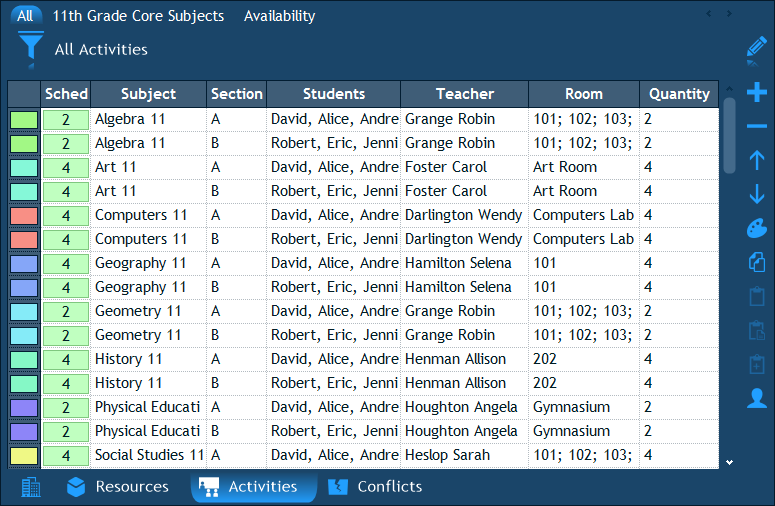
How to select which columns are visible?
As you have learned from the scenarios above, the activities' list can look quite differently - according to each institution's needs. The selection of which columns you would like to see in this list is made in the Institution pane's Properties page (under the Activity item). What you need to do in that page is this:
- Select which properties are enabled by placing a check mark near the relevant properties.
- Set the widths of the columns that you would like to see in the activities' list.
- If required, add custom properties (such as "Section" for instance).
Here is an example of how the columns are configured to achieve the look of the first scenario above:
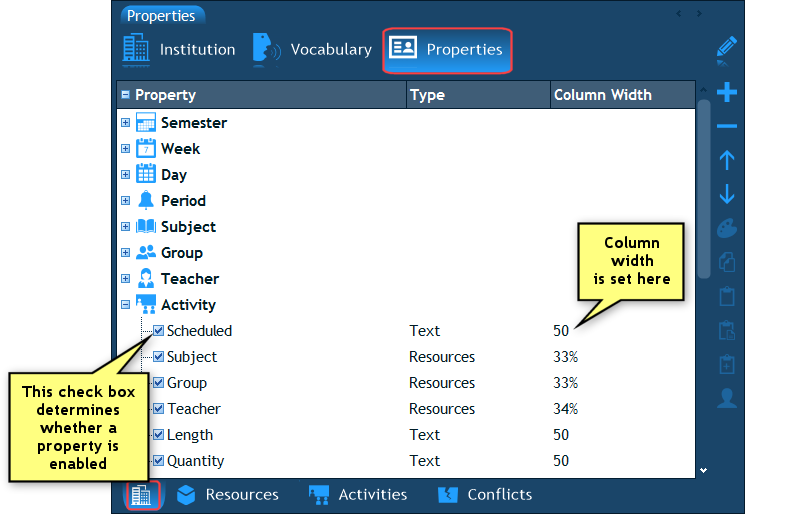
Once finished, click the Activities tab and you will see the effect of your configuration.
Entry of Activities
The Activities pane at the right hand side of the workspace is where the entry of activities takes place. In this section we will explain how to add activities to it and how to edit them efficiently.
How to add activities?
The list of activities is built like a spreadsheet, where each row is a separate activity and the columns are the activity's resources. Since the spreadsheet is empty at the beginning, you can start by adding a few rows. To do this, click the plus button at the right hand side toolbar and select the second option: "Activities (20)". This will add 20 new rows to the list. If you would like to add a single row you can select the first option - "Activity".
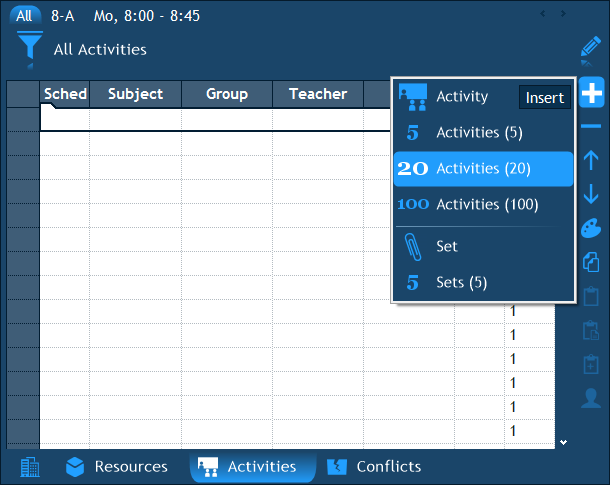
How to edit activities?
Just like during the entry of resources, there are two places where you can fill in the values of an activity: either by selecting the activity and then using the Properties pane or by enabling the Editing mode (by clicking the pencil button at the right hand side toolbar) and then editing the values inside the spreadsheet. Since we are starting with a blank spreadsheet here, it is usually more comfortable and faster to start entering the activities in the Editing mode.
How to fill in the values of an activity?
Once we have added a few empty rows to the list, and we have enabled the Editing mode, we can start filling in the first activity's resources. The process is simple. First click inside the cell that you are going to fill, then click the button with the arrow to display a popup list of resources. Next to each resource in the popup list there is a check box. By clicking inside that check box you select a resource. If you click inside the check box again, you deselect a resource. When finished, click anywhere outside the popup list. You will then see the resources that you have selected appear inside the cell.
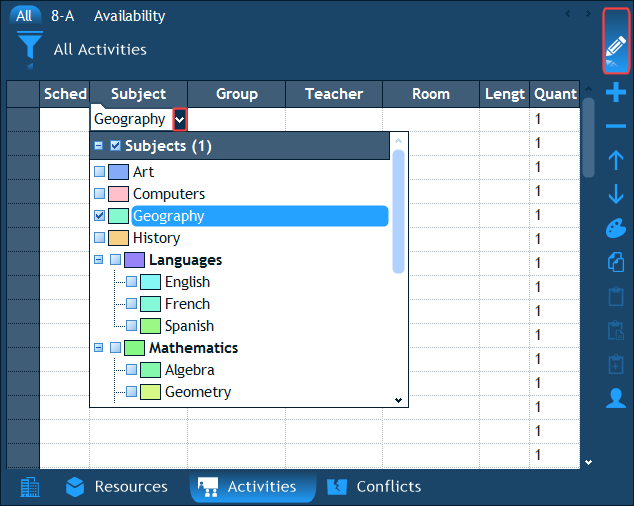
How to quickly select a single resource in a popup list?
If you are planning to select only a single resource inside a popup list, you can simply click the resource's name (instead of clicking in the check box near the name). If you do this, only that resource will be selected and the popup list will immediately close (and you won't have to make another click outside the popup list). This speeds up the process because in many cases all you need to do is select a single resource. This trick works in all popup lists throughout the program.
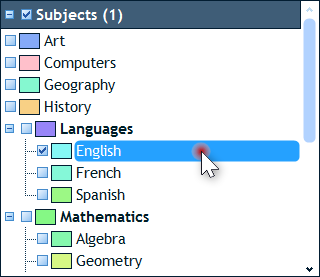
How to modify a property of multiple activities at once?
In order to help you speed up the entry of activities, there are certain things that you can do in order to avoid doing the same thing over and over again. For example, when you need to set the same value to multiple activities, you do not need to go over each activity one by one. Instead, there are 2 things that you can do:
- The first option is to use the Properties pane after having selected multiple activities. To select multiple activities you can hold down the Ctrl key on the keyboard while clicking the activities, or by selecting the first activity and then, while holding down the Shift key, selecting the last activity. Once you have a range of activities selected, you just need to make a selection in the Properties pane and that selection will be applied to all the selected activities.
- The second option is to use copy/paste in the Editing mode. Select a cell in the spreadsheet that you would like to replicate and press Ctrl+C (copy) on the keyboard. Then, select the target cells and press Ctrl+V (paste) on the keyboard.
How to quickly create an activity for each resource?
Suppose you have 50 teachers in your school, and you would like to create 50 activities - one for each teacher. Instead of selecting teachers separately 50 times in 50 rows, what you can do is the following:
- First select all the teachers for a single activity by clicking the check box at the top of the popup list. This is like creating one activity which involves 50 teachers:
- Now select the cell with the 50 teachers and copy it by pressing Ctrl+C on the keyboard.
- If you haven't already, add enough new empty rows (at least 50 in this case) to the list using the plus button.
- Select the first empty row that you have added, right click and select "Paste One by One" (or press Ctrl+1 on the keyboard; or click the second paste button in the toolbar):
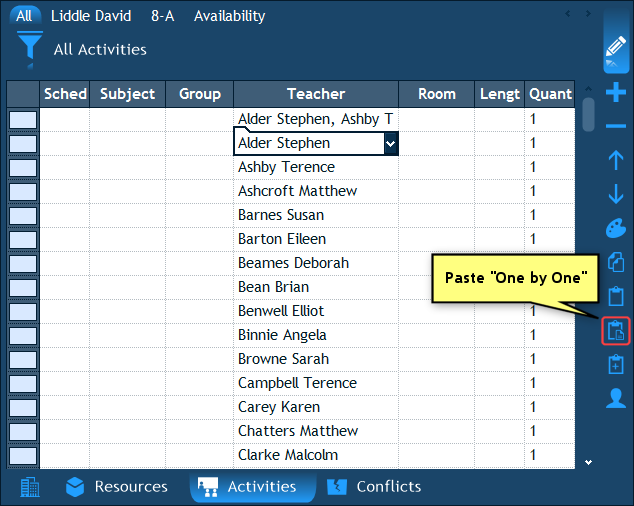
- Explanation: The "Paste One by One" function pastes the values that you have copied one by one to each activity. After having copied a value of multiple resources, this function pastes each resource on a separate row. By the way, if you copy several cells so that each of them contains several resources (for example copy two cells of an activity: 50 teachers and 10 rooms), the program will paste all the possible combinations of them (500 in this example).
- Finally, you can delete the first row (if you have no use for it) by selecting it and then clicking the minus button in the toolbar.
How to select multiple items of the same equipment?
As you remember, each type of equipment can have several items of it available in stock. Although usually a single activity would require a single item of some equipment, the program does support the rare cases in which more than 1 item of the same equipment is needed by an activity. To accommodate for this need, the drop down list of equipment has a "Quantity" column. You can click inside that column next to the relevant equipment and use the arrow button to increase the number of items (or type the exact number using the keyboard) up to the maximal available quantity:
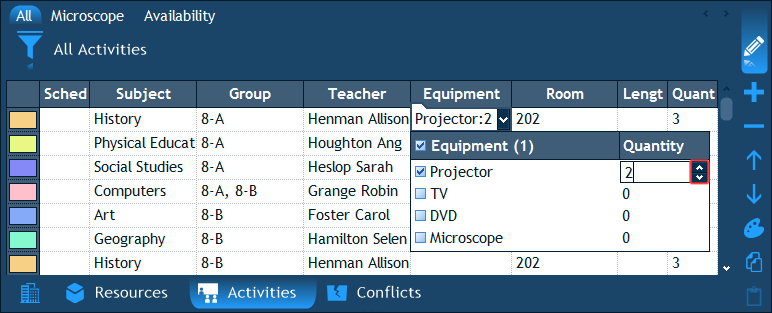
How to enter length and quantity?
The Length and the Quantity fields of an activity are textual fields which are entered using the keyboard. Click inside one of these fields and then type a value such as "2" (i.e. 2 periods). If the quantity is not important or unlimited you can type "0" in the Quantity field (and the zero will turn into the infinity symbol). If the length is equal to 1 period, you can leave the length field empty because 1 period is the default. In any other case, you should fill in the length.

If the activity has different lengths on different days, fill in the minimal length here so that when you drag and drop the activity you will have something to start from. Remember that you always have the option to adjust any cell's length after it has already been scheduled using the Properties pane or by holding down the Shift key while dragging the cell's time markers.
Sets
A Set is a bundle of several activities which need to be scheduled at the same time, i.e. simultaneously.
Often, when students are divided to several activities based on their level in some subject or based on their subjects of interest, all these activities are required to be scheduled at the same time. For example, in a high school in which students pick their major subject, some students could be studying Chemistry while others are studying Computer Programming. Both activities are preferred to be scheduled at the same time slot so that all students are occupied.
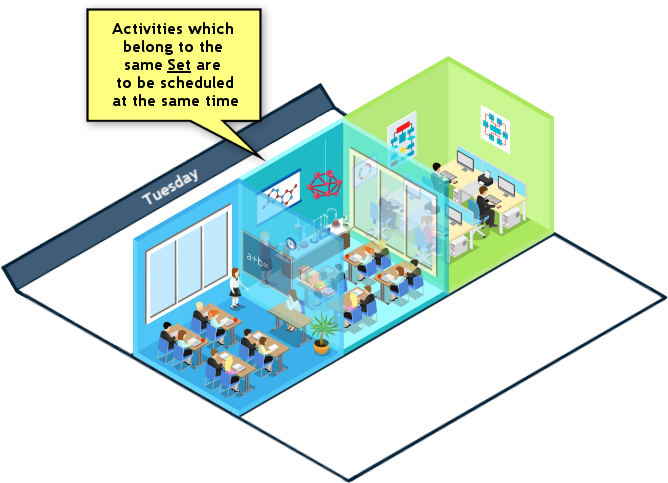
In the list of activities, Sets appear as a kind of colored folders of multiple rows (as opposed to regular activities which are standalone white rows). The color of a set can be chosen in the Properties pane. A Set can also have a name (title) which appears at the first row. This title is displayed in all the cells in which the Set is scheduled. Here is an example of a Set of 3 simultaneous activities:
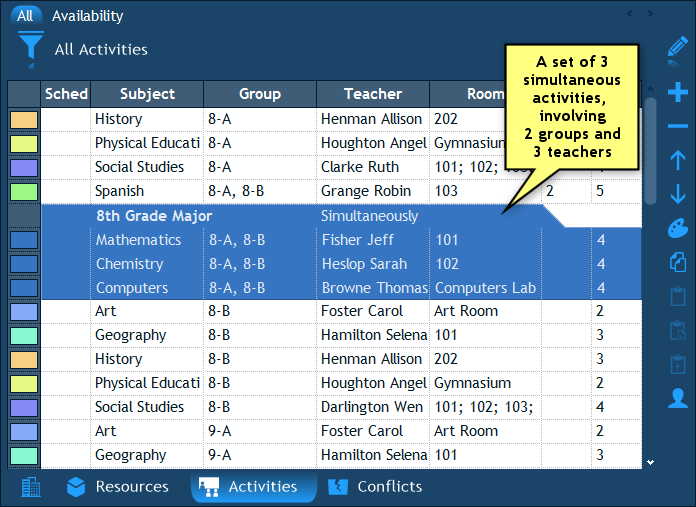
Some notes about Sets:
- All the activities of a Set are scheduled together both in the Interactive and the Automatic mode of timetable construction. In the Interactive mode, when you drag-and-drop or delete any of the set's activities, all the set's activities are moved or deleted together. In the Automatic mode, the program schedules all the set's activities at the same time automatically.
- The Quantity and Length of each activity in a Set needs to be set separately. It is recommended that all activities have the same quantity and length.
- Each activity in a Set can be configured to have several optional rooms in which it can be scheduled (by selecting "Any of the selected resources" at the bottom of the rooms popup list). In the Automatic mode, the program will pick a room for each activity individually.
- Activities in the same Set can involve the same resources. For example, two activities in a Set can be for the same group or teacher. This is an allowed situation and when such two activities are scheduled simultaneously, it is not considered as a conflict by the program (because they belong to the same Set).
How to create a set?
To create a new Set, click the plus button at the right hand side toolbar and select "Set". The new set will be inserted after the currently selected row.
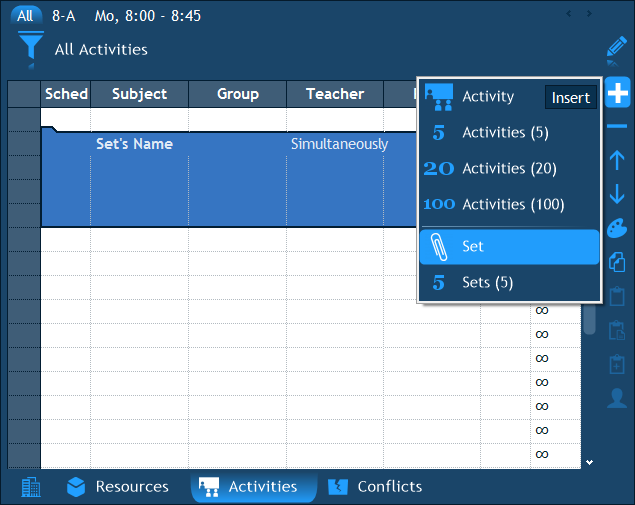
By default, a Set is created with 3 empty activities. If you need the set to have more than 3 activities, click anywhere inside the Set, then click the plus button again and select "Activity". A new activity will be added to the Set. If you need the set to have less than 3 activities, you can delete the unnecessary activities by selecting them and then clicking the minus button.
Note: You must have the Editing Mode turned on (the pencil button at the top right corner) in order to be able to select discrete activities inside a Set. If the editing mode is turned off, clicking inside any of the set's activities will automatically select the entire Set.
How to enter a set's title and color?
As we have already mentioned before, a Set has a title. All the cells in the timetable in which the Set is scheduled display the title of the Set. If you click inside the first column of the first row of the Set you will be able to type the Set's title (assuming the Editing Mode is turned on). You can also type the title in the Properties pane, by filling in the set's Name property.
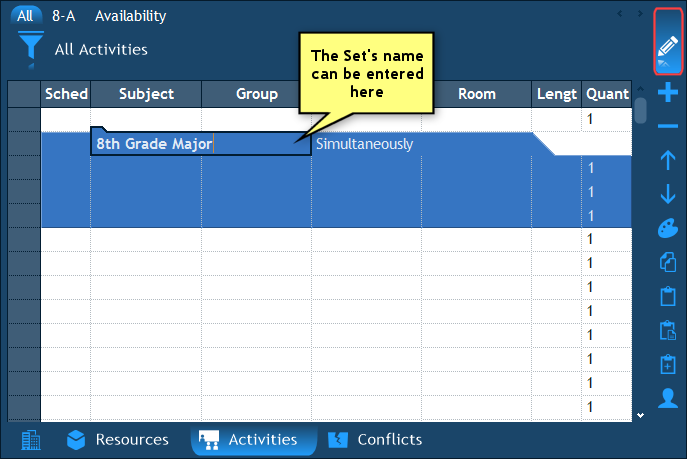
A set also has a color assigned to it. That color has precedence over the colors assigned to the distinct resources participating in the Set's activities. As a result, the cells in which the Set's activities are scheduled will have the Set's color and not the resources' colors (like other cells). The Set's color can only be chosen using the Properties pane: first select the Set in the activities' list and then choose the color in the Color property.
Note: Just like in the resources entry phase, you can assign colors automatically to all the Sets in your database using the Colors button at the right hand side toolbar. It is recommended to assign dark colors to Sets (select the option "Assign random dark colors" in the Colors popup menu), so that they stand out from the rest of the activities in the timetable.
How to add an existing activity to a set?
If you have already entered an activity somewhere in the spreadsheet and you would like to add it to a Set, here is how:
- First click inside any cell of the activity. The activity's properties will then be displayed in the Properties pane at the bottom right corner.
- Notice the property "Set". If you click where it says "Click to choose…" near that property, you will see a popup list of all the Sets in your database:
- Select the newly added set. Note that unless you have already had a chance to modify the set's properties, its default color would be blue and it would not have a title so it would just appear as "Set" in the popup list.
- Once you do the above, the activity will be added to the set:
How to remove an activity from a set?
In order to remove an activity from a Set, you need to use the same property. Just deselect the selected set in the popup list by clicking inside the check box near the set's name in order to clear the check mark. The activity will be removed from the set and will be restored to the state of a standalone activity:
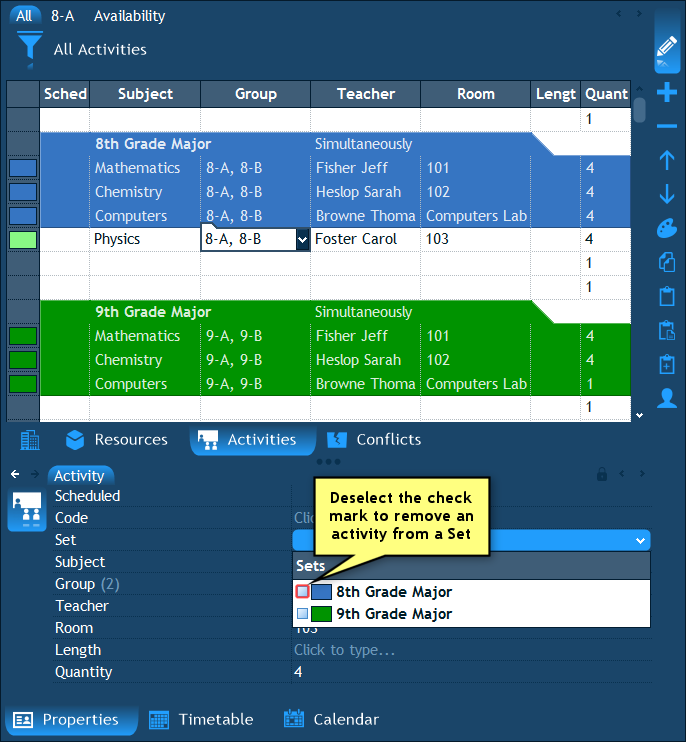
Assisted Assignment of Resources
In many schools, the task of creating the list of activities is by itself a complicated logical problem. Challenges such as efficient allocation of teachers to classes, enrollment of students to activities, room assignment and the need to meet planned quotas often make this phase of data entry quite complex. By providing key information to the program, as explained below, you can allow it to help you ease this process.
Which subjects can a teacher teach?
Naturally, in most cases, one teacher cannot teach every subject. So if you specify the subjects which each teacher can teach, the program will be able to narrow down the list from which you pick a teacher for the activity - to only the teachers which are associated with the activity's subject.

The selection of the subjects which a teacher can teach is made in the teacher's properties. You need to be in the Resources pane and click the Teachers icon at the top. Then, select a teacher in the list and in the Properties pane you will see the Subjects property. You can select one or more subjects in that field:
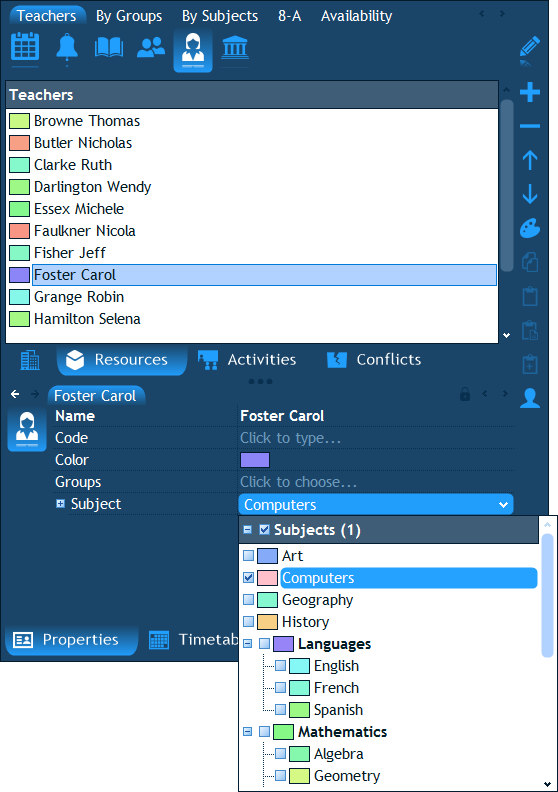
Once you have done that, when you pick a teacher for an activity, the program will automatically know how to narrow down the popup list to only the relevant teachers - only those that teach the subject of the activity:
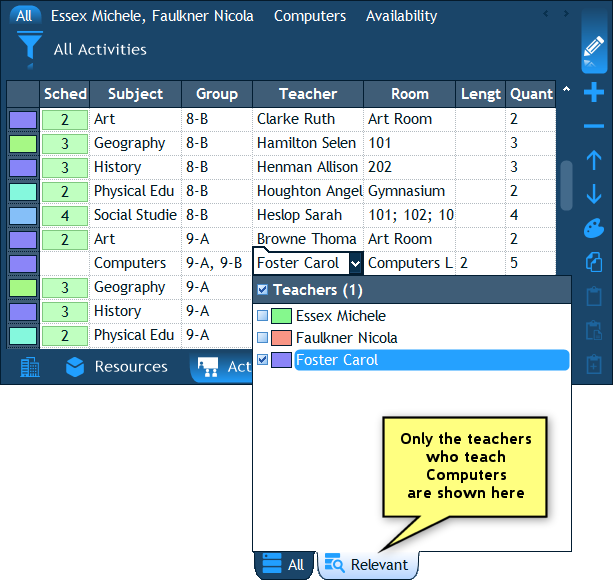
Note: You can always click the "All" tab at the bottom of the popup list (instead of "Relevant") to pick any other teacher.
What is the maximal capacity of a room?
By entering the maximal number of students that can fit in a room, the program can filter out the rooms which are too small to accommodate for an activity (which has a greater number of students).
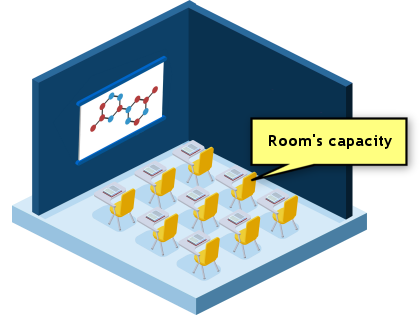
The number of students in an activity is known to the program either from looking at the students who are directly enrolled to the activity (in case your school constructs individual student schedules) or by manually entering this number for each activity. Let's go over the exact steps.
The first step is to set the maximal number of students a room can contain. This is defined in the room's properties:
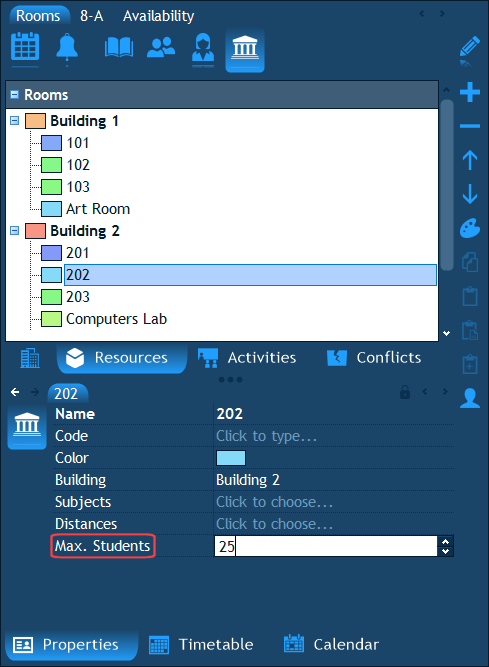
Note: In order to enter these values quickly, you can configure the "Max. Students" property to be displayed in a separate column in the list of rooms (by setting the column width of this property in the Institution pane). Then by turning on the Editing mode you can set these values quickly using the keyboard one by one.
What is left for us to do is to make sure the program knows how many students participate in each activity. If the activities in your school contain an explicit list of students - there is nothing more to do because the program will deduce the total number of students automatically. If not, however, you need to enter the number of students in each activity manually.
Note: By default, the manual number of students property for a group or an activity is disabled (because the default is working with explicit students). To enable it, go to the Institution pane, to the Properties page, and under "Group" or "Activity" place a check mark near "No. of Students (Manual)":
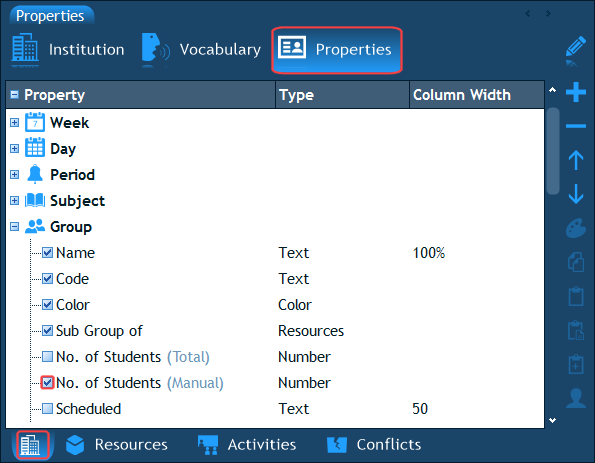
After having done that, you can enter this number per group or activity in the Properties pane like this:
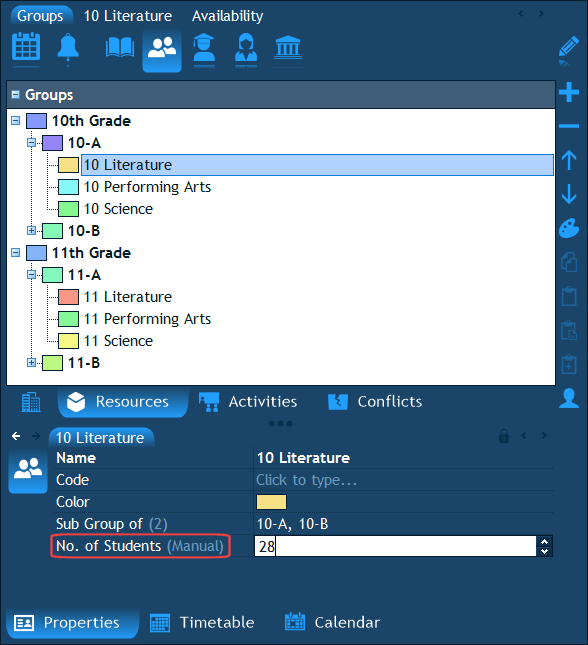
That's it. Now any time you need to pick a room for an activity, the program will display only the relevant rooms - the ones which are large enough to host all the students of the activity.
What is the maximal number of periods a teacher can teach?
Since each activity has a Quantity property which designates the total number of periods the activity is planned to occupy during the week, we can sum up all the quantities of the activities in which a certain teacher teaches and come up with the total planned quantity for that teacher. That would be the amount of his/her planned work periods.
Now, during the creation of activities there is often a choice between assigning one teacher to an activity or another (assuming both can teach the subject). What is usually important to consider in this case, is the number of work periods that we have already assigned to each of those two teachers compared to their maximal possible (or desirable) quantity. We can actually enter this maximal value into the program - thus making it possible for the program to show us what that difference is - any time we need to assign a teacher to an activity. Let's see how this is done.
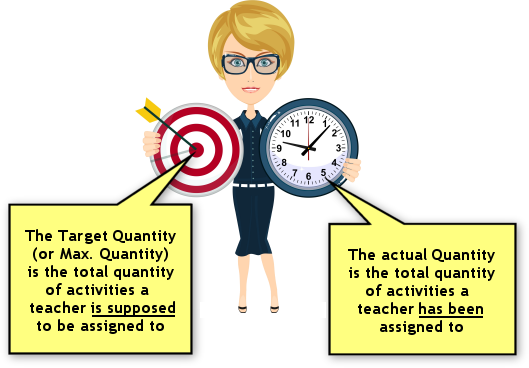
In order to be able to enter the maximal planned quantity of periods for a teacher, first we need to enable the "Max. Quantity" property in the Institution pane. Let's also enable the "Quantity" property and the "Unassigned Quantity" to demonstrate what each of them means:
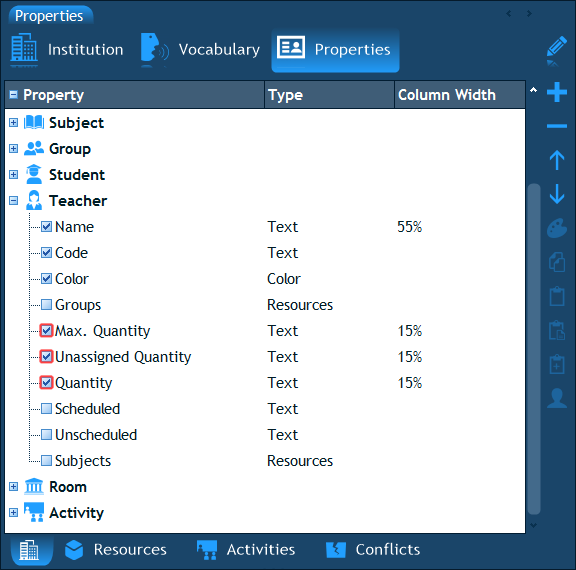
Having done that, if we now take a look at the list of teachers in the middle of the process of the creation of activities, it would look something like this:
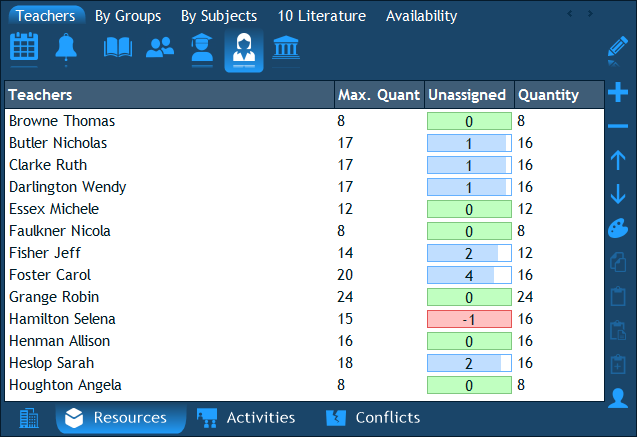
While our list of activities looks like this:
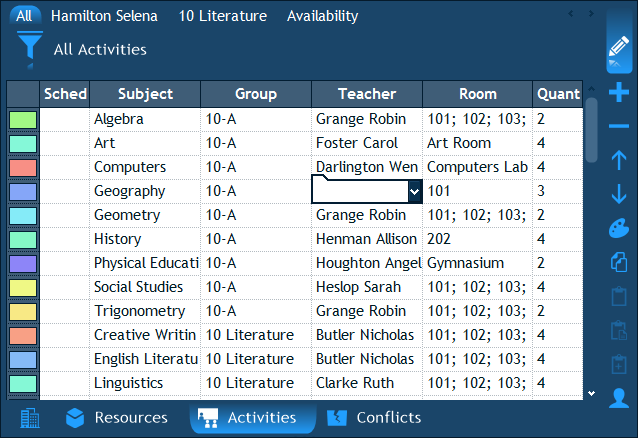
Now, when we are assigning a teacher to the "Geography" activity, for example, the program naturally shows us only the relevant Geography teachers, but also another thing - it displays the total amount of "Unassigned Quantity" in the same popup list. The "Unassigned Quantity" is equal to the "Max. Quantity" that we have entered before minus the teacher's total "Quantity" (which is the sum of the quantities of all activities in which the teacher teaches). This value allows us to know instantly which teachers have met their planned quota as opposed to those which still need activities to be assigned to them:
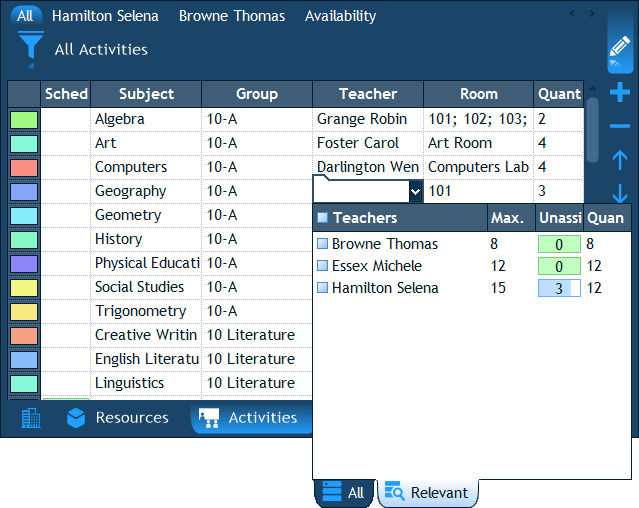
The next chapter: Interactive Timetabling.
 Have a question? Email us at SUPPORT@LANTIV.COM
Have a question? Email us at SUPPORT@LANTIV.COM
